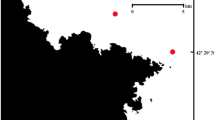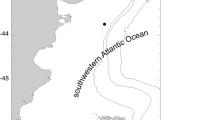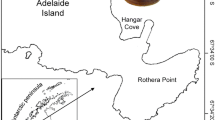Abstract
The Arctic polychaete, Oligobrachia haakonmosbiensis (Family Siboglinidae), is the most abundant symbiotic species inhabiting the Haakon Mosby Mud Volcano (Norwegian Sea, depth 1250 m). Different aspects of gametogenesis, fecundity, embryogenesis, and larval development were studied using biometric measurements, classical histology, and scanning electron microscopy on specimens (n = 15) collected in July 2009 at two sites (72° 00.28′ N, 14° 43.36′ E; 72° 00.33 ′N, 14° 43.22′ E). Several cohorts of oocytes, from oogonia to mature oocytes were observed in brooding females. Embryos with 16–64 cell divisions, trochophore and metatrochophore larvae, were found, in sequence, in female tubes, from just above the tentacles to the anterior end of the tube. Trochophores had both a prototroch and a telotroch; metatrochophores had an additional ciliary band, the neurotroch, but lacked a down-stream feeding system. All female reproductive stages, oocytes, embryos, and larvae, were recovered in a single specimen suggesting the release of different batches of oocytes at least on the date of collection, which coincided with the boreal summer. Only one brooding female contained exclusively germ cells in the gonad suggesting a pause in reproduction. Fecundity was low: a maximum of 60 mature oocytes per female was counted, and if all the different stages of oocytes, embryos, and larvae were combined, a total fecundity of ~ 250–300 propagules was found in each female. This study advances knowledge of the reproductive biology of O. haakonmosbiensis and has particular significance for understanding the distribution of this ecologically important deep-sea chemosymbiotic species in the Arctic region. The new data on life-history traits are critical for modeling, and predicting dispersal potential and connectivity among cold seeps in the Arctic, which is an essential component of marine spatial management.




Similar content being viewed by others
References
Allen JD, Pernet B (2007) Intermediate modes of larval development: bridging the gap between planktotrophy and lecithotrophy. Evol Dev 9:643–653. https://doi.org/10.1111/j.1525-142X.2007.00202.x
AMAP (2017) Water, ice and permafrost in the Arctic (SWIPA). Arctic monitoring and assessment programme (AMAP). Oslo, Norway, xiv + 269 pp
Bakke T (1976) The early embryos of Siboglinum fiordicum Webb (Pogonophora) reared in the laboratory. Sarsia 60:1–12. https://doi.org/10.1080/00364827.1976.10411291
Bright M, Lallier FH (2010) The biology of Vestimentiferan tubeworms. Oceanogr Mar Biol 48:213–265
Callsen-Cencic P, Flügel HJ (1995) Larval development and the formation of the gut of Siboglinum poseidoni Flügel & Langhof (Pogonophora, Perviata), evidence of protostomian affinity. Sarsia 80:73–89. https://doi.org/10.1080/00364827.1995.10413582
Collin R (2012) Non traditional life-history choices: what can ‘intermediates’ tell us about evolutionary transitions between modes of invertebrate development? Integr Comp Biol 52:128–137. https://doi.org/10.1093/icb/ics065
Corliss JB, Dymond J, Gordon LI, Edmond JM, von Herzen RP, Ballard RD, Green K, Williams D, Bainbridge A, Crane K, van Andel TH (1979) Submarine thermal springs on the Galapagos Rift. Science 203:1073–1083. https://doi.org/10.1126/science.203.4385.1073
Damen P, Dictus WJAG (1994) Cell lineage of the prototroch of Patella vulgata (Gastropoda, Mollusca). Dev Biol 162:364–383. https://doi.org/10.1006/dbio.1994.1094
Dando PR, Southward AJ, Southward EC, Lamont P, Harvey R (2008) Interactions between sediment chemistry and frenulate pogonophores (Annelida) in the north-east Atlantic. Deep Sea Res I 55:966–996. https://doi.org/10.1016/j.dsr.2008.04.002
Dubilier N, Bergin C, Lott C (2008) Symbiotic diversity in marine animals: the art of harnessing chemosynthesis. Nat Rev Microbiol 6:725–740. https://doi.org/10.1038/nrmicro1992
Eichinger I, Hourdez S, Bright M (2013) Morphology, microanatomy and sequence data of Sclerolinum contortum (Siboglinidae, Annelida) of the Gulf of Mexico. Org Divers Evol 13:311–329. https://doi.org/10.1007/s13127-012-0121-3
Flügel H (1977) Ultrastructure of the spermatophores of Siboglinum ekmani Jägersten (Pogonophora). Nature 269:800–801
Flügel HJ, Langhof I (1983) A new hermaphroditic pogonophore from the Skagerrak. Sarsia 68:131–138. https://doi.org/10.1080/00364827.1983.10420564
Gaudron SM, Pradillon F, Pailleret M, Duperron S, Le Bris N, Gaill F (2010) Colonization of organic substrates deployed in deep-sea reducing habitats by symbiotic species and associated fauna. Mar Environ Res 70:1–12. https://doi.org/10.1016/j.marenvres.2010.02.002
Gebruk AV, Krylova EM, Lein AY, Vinogradov GM, Anserson E, Pimenov NV, Cherkashev GA, Crane K (2003) Methane seep community of the Håkon Mosby mud volcano (the Norwegian Sea): composition and trophic aspects. Sarsia 88:394–403. https://doi.org/10.1080/00364820310003190
Halanych KM, Feldman RA, Vrijenhoek RC (2001) Molecular evidence that Sclerolinum brattsomi is closely related to vestimentiferans, not to Frenulate pogonophorans (Siboglinidae, Annelida). Biol Bull 201:65–75. https://doi.org/10.2307/1543527
Hilário A, Young CM, Tyler PA (2005) Sperm Storage, internal fertilization, and embryonic dispersal in vent and seep tubeworms (Polychaeta: Siboglinidae: Vestimentifera). Biol Bull 208:20–28. https://doi.org/10.2307/3593097
Hilário A, Vilar S, Cunha MR, Tyler P (2009) Reproductive aspects of two bythograeid crab species from hydrothermal vents in the Pacific-Antarctic Ridge. Mar Ecol Prog Ser 378:153–160. https://doi.org/10.3354/meps07858
Hilário A, Capa M, Dahlgren TG, Halanych KM, Little CTS, Thornhill DJ, Verna C, Glover AG (2011) New perspectives on the ecology and evolution of Siboglinid tubeworms. PLoS ONE ONE 6:e16309. https://doi.org/10.1371/journal.pone.0016309
Hilário A, Metaxas A, Gaudron SM, Howell KL, Mercier A, Mestre N, Ross RE, Thurnherr AM, Young C (2015) Estimating dispersal distance in the deep sea: challenges and applications to marine reserves. Front Mar 2:1–14. https://doi.org/10.3389/fmars.2015.00006
Ivanov AV (1957) Material on the embryological development of the Pogonophora. Zoologicheskii Zhurnal 36:1127–1144
Ivanov AV (1960) Embranchement des Pogonophores. In: Grassé P (ed) Traité de Zoologie 5(1). Masson, Paris, pp 1521–1622
Ivanov AV (1963) Pogonophora. Academic Press, London, p 479
Katz S, Rouse GW (2013) The reproductive system of Osedax (Annelida, Siboglinidae): ovary structure, sperm ultrastructure, and fertilization mode. Invertebr Biol 132:368–385. https://doi.org/10.1111/ivb.12037
Klages M et al. (2010) The expedition of the Research Vessel “Polastern” to the Arctic in 2009 (ARK-XXIV/2). Polar and marine research report 607, 80 pp. https://epic.awi.de/id/eprint/29180/1/Kla2010c.pdf
Lett C, Ayata S-D, Huret M, Irisson J-O (2010) Biophysical modelling to investigate the effects of climate change on marine population dispersal and connectivity. Prog Oceanogr 87:106–113. https://doi.org/10.1016/j.pocean.2010.09.005
Lösekann T, Robador A, Niemann H, Knittel K, Boetius A, Dubilier N (2008) Endosymbioses between bacteria and deep-sea siboglinid tubeworms from an Arctic Cold Seep (Haakon Mosby Mud Volcano, Barents Sea). Environ Microbiol 10:3237–3254. https://doi.org/10.1111/j.1462-2920.2008.01712.x
Marsh AG, Mullineaux LS, Young CM, Manahan DT (2001) Larval dispersal potential of the tubeworm Riftia pachyptila at deep-sea hydrothermal vents. Nature 411:77–80
Milkov AV, Vogt PR, Crane K, Lein AY, Sassen R, Cherkashev GA (2004) Geological, geochemical, and microbial processes at the hydrate-bearing Håkon Mosby mud volcano: a review. Chem Geol 205:347–366. https://doi.org/10.1016/j.chemgeo.2003.12.030
Nielsen C (1995) Animal evolution. Interrelationships of the living phyla. Oxford University Press, Oxford
Niemann H, Lösekann T, De Beer D, Elvert M, Nadalig T, Knittel K, Amann R, Sauter EJ, Schlüter M, Klages M, Foucher JP, Boetius A (2006) Novel microbial communities of the Haakon Mosby mud volcano and their role as a methane sink. Nature 443:854–858. https://doi.org/10.1038/nature05227
Pearse JS, Mooi R, Lockhart SJ, Brandt A (2009) Brooding and species diversity in the Southern Ocean: selection for brooders or speciation within brooding clades? In: Krupnik I, Lang MA, Miller SE (eds). Smithsonian at the poles: contributions to international polar year science, pp 181–196
Pleijel F, Dahlgren TG, Rouse GW (2009) Progress in systematics: from Siboglinidae to Pogonophora and Vestimentifera and back to Siboglinidae. C R Biol 332:140–148. https://doi.org/10.1016/j.crvi.2008.10.007
Poulin E, Féral J-P (1996) Why are there so many species of brooding Antarctic echinoids? Evolution 50:820–830. https://doi.org/10.1111/j.1558-5646.1996.tb03891.x
Rice SA (1980) Ultrastructure of the male nephridium and its role in spermatophore formation in spionid polychaetes (Annelida). Zoomorphology 95:181–194. https://doi.org/10.1007/BF00998121
Rouse GW (1999) Trochophore concepts: ciliary bands and the evolution of larvae in spiralian Metazoa. Biol J Linn Soc 66:411–464. https://doi.org/10.1111/j.1095-8312.1999.tb01920.x
Rouse GW (2001) A cladistic analysis of Siboglinidae Caullery, 1914 (Polychaeta, Annelida): formerly the phyla Pogonophora and Vestimentifera. Zool J Linn Soc 132:55–80. https://doi.org/10.1111/j.1096-3642.2001.tb02271.x
Rouse GW (2006) Annelid larval morphology. In: Rouse G and Pleijel F (eds) Reproductive biology and phylogeny of annelida. Science Publishers, pp 141–188
Schmaljohann R, Flügel HJ (1987) Methane oxidizing bacteria in Pogonophora. Sarsia 72:91–98. https://doi.org/10.1080/00364827.1987.10419707
Sen A, Åström EKL, Hong WL, Portnov AD, Waage M, Serov P, Carrol ML, Carroll J (2018a) Geophysical and geochemical controls on the megafaunal community of a high Arctic cold seep. Biogeosciences 15:4533–4559. https://doi.org/10.5194/bg-15-4533-2018
Sen A, Duperron S, Hourdez S, Piquet B, Léger N, Gebruk A, Port AL, Svenning MM, Andersen AC (2018b) Cryptic frenulates are the dominant chemosymbiotrophic fauna at Arctic and high latitude Atlantic cold seeps. PLoS ONE ONE 13:e0209273. https://doi.org/10.1371/journal.pone.0209273
Sibuet M, Olu K (1998) Biogeography, biodiversity and fluid dependence of deep-sea cold-seep communities at active and passive margins. Deep Sea Res II 45:517–567. https://doi.org/10.1016/S0967-0645(97)00074-X
Smirnov RV (1999) A new genus and two new species of pogonophores from the Northern Ocean. Biol Morya 25:281–287
Smirnov RV (2000) Two new species of Pogonophora from the Arctic mud volcano off northwestern Norway. Sarsia 85:141–150. https://doi.org/10.1080/00364827.2000.10414563
Smirnov RV (2005) New species of the genus Polarsternium (Pogonophora) from the Scotia Sea and adjacent waters of the Antarctic. Russ J Mar Biol 31:146–154. https://doi.org/10.1007/s11179-005-0059-9
Smirnov RV (2014) A revision of the Oligobrachiidae (Annelida: Pogonophora), with notes on the morphology and distribution of Oligobrachia haakonmosbiensis Smirnov. Mar Biol Res 10:972–982. https://doi.org/10.1080/17451000.2013.872799
Southward AJ, Southward EC (1963) Notes on the biology of some Pogonophora. J mar biol Ass UK 43:57–64. https://doi.org/10.1017/S0025315400005233
Southward EC (1993) Pogonophora. In: Harrison FW, Rice ME (eds) Microscopic anatomical of invertebrates, vol 12. Wiley-Liss, New York, pp 327–369
Southward EC (1999) Development of Perviata and Vestimentifera (Pogonophora). Hydrobiologia 402:185–202. https://doi.org/10.1023/A:1003796626851
Southward EC, Schulze A, Gardiner SL (2005) Pogonophora (Annelida): form and function. Hydrobiologia 535–536:227–251. https://doi.org/10.3354/meps11172
Strathmann RR (1993) Hypotheses on the origin of marine larvae. Annu Rev Ecol Syst 24:89–117. https://doi.org/10.1146/annurev.es.24.110193.000513
Szafranski K, Gaudron SM, Duperron S (2014) Direct evidence for maternal inheritance of bacterial symbionts in small deep-sea clams (Bivalvia: Vesicomyidae). Naturwissenschaften 101:373–384. https://doi.org/10.1007/s00114-014-1165-3
Thomson CW (1878) The voyage of the ‘Challenger’: the Atlantic; a preliminary account of the general results of the exploring voyage of HMS ‘Challenger’ during the year 1873 and the early part of the year 1876, 391 pp
Thorson G (1950) Reproductive and larval ecology of marine bottom invertebrates. Biol Rev 25:1–45. https://doi.org/10.1111/j.1469-185X.1950.tb00585.x
Tyler PA, Young CM (1999) Reproduction and dispersal at vents and cold seeps. J Mar Biol Ass UK 79:193–208. https://doi.org/10.1017/S0025315499000235
Vogt PR, Cherkashev G, Ginsburg G, Ivanov G, Milkov A, Crane K, Lein A, Sundvor E, Pimenov N, Egorov A (1997) Haakon Mosby Mud Volcano provides unusual example of venting. Eos Trans Am Geophys Union 78:549–557. https://doi.org/10.1029/97EO00326
Vogt PR, Gardner J, Crane K (1999) Ground-truthing 11-to 12-kHz side-scan sonar imagery in the Norwegian Greenland Sea: Part I: Pockmarks on the Vestnesa Ridge and Storegga slide margin. Geo-Marine Lett 19:97–110. https://doi.org/10.1007/s003670050098
Young CM (1994) A tale of 2 dogmas: the early history of deep-sea reproductive biology. In: Young CM, Eckelbarger KJ (eds) Reproduction, larval biology and recruitment of the deep-sea benthos. Columbia Univ Press, New York, pp 1–25
Young CM (1999) Synchrony and sociability: breeding strategies in constant and variable environments. In: Whitefield M, Matthews J, Reynolds C (eds) Aquatic life cycle strategies: survival in a variable environment. Mar Biol Ass UK, Plymouth, pp 1–14
Young CM (2003) Reproduction, development and life-history traits. In: Tyler PA (ed) Ecosystems of the deep oceans. Elsevier, Amsterdam, pp 381–425
Young CM, He R, Emlet RB, Li Y, Qian H, Arellano SM, Van Gaest A, Bennett KC, Wolf M, Smart TI, Rice ME (2012) Dispersal of deep-sea larvae from the intra-American seas: simulations of trajectories using ocean models. Integr Comp Biol 52:483–496. https://doi.org/10.1093/icb/ics090
Webb M (1963) Siboglinum fiordicum sp. nov. from Raunefjord, western Norway. Sarsia 13:33–44. https://doi.org/10.1080/00364827.1963.10409515
Acknowledgements
We thank the captain, pilots, and crew of RV Polarstern and ROV QUEST 4000 (MARUM) during the cruise ARK-XXIV/2 (Chief scientist: Michael Klages). The initial research was funded by CHEMECO ESF EURODEEP (EURODEEP/0001/2007). We are grateful to Amandine Nunes Jorge who was on board in July 2009 to collect and fix the samples. M. Mammone was funded for her Master’s Project by Erasmus grant (EU) and by University of Lille, CNRS and Station Marine of Wimereux. A. Hilário is supported by CESAM (UID/AMB/50017/2019) that is funded by FCT/MCTES through national funds, and co-funded by FEDER, within the PT2020 Partnership Agreement and Compete 2020.
Author information
Authors and Affiliations
Corresponding author
Ethics declarations
Conflict of interest
All authors declare that they have no conflict of interest. All applicable international, national, and/or institutional guidelines for the care and use of animals were followed in accordance with the ethical standards as laid down in the 1964 Declaration of Helsinki and its later amendments or comparable ethical standards. The data sets analyzed during the current study are available from the corresponding author on reasonable request.
Additional information
Responsible Editor: J. Grassle.
Publisher's Note
Springer Nature remains neutral with regard to jurisdictional claims in published maps and institutional affiliations.
Reviewed by K. Eckelbargr, A. Sen, and R. V. Smirnov.
Electronic supplementary material
Below is the link to the electronic supplementary material.
Rights and permissions
About this article
Cite this article
Mammone, M., Courcot, L., Hilário, A. et al. Brooding strategy of the Arctic cold seep polychaete Oligobrachia haakonmosbiensis. Mar Biol 167, 42 (2020). https://doi.org/10.1007/s00227-020-3656-4
Received:
Accepted:
Published:
DOI: https://doi.org/10.1007/s00227-020-3656-4




